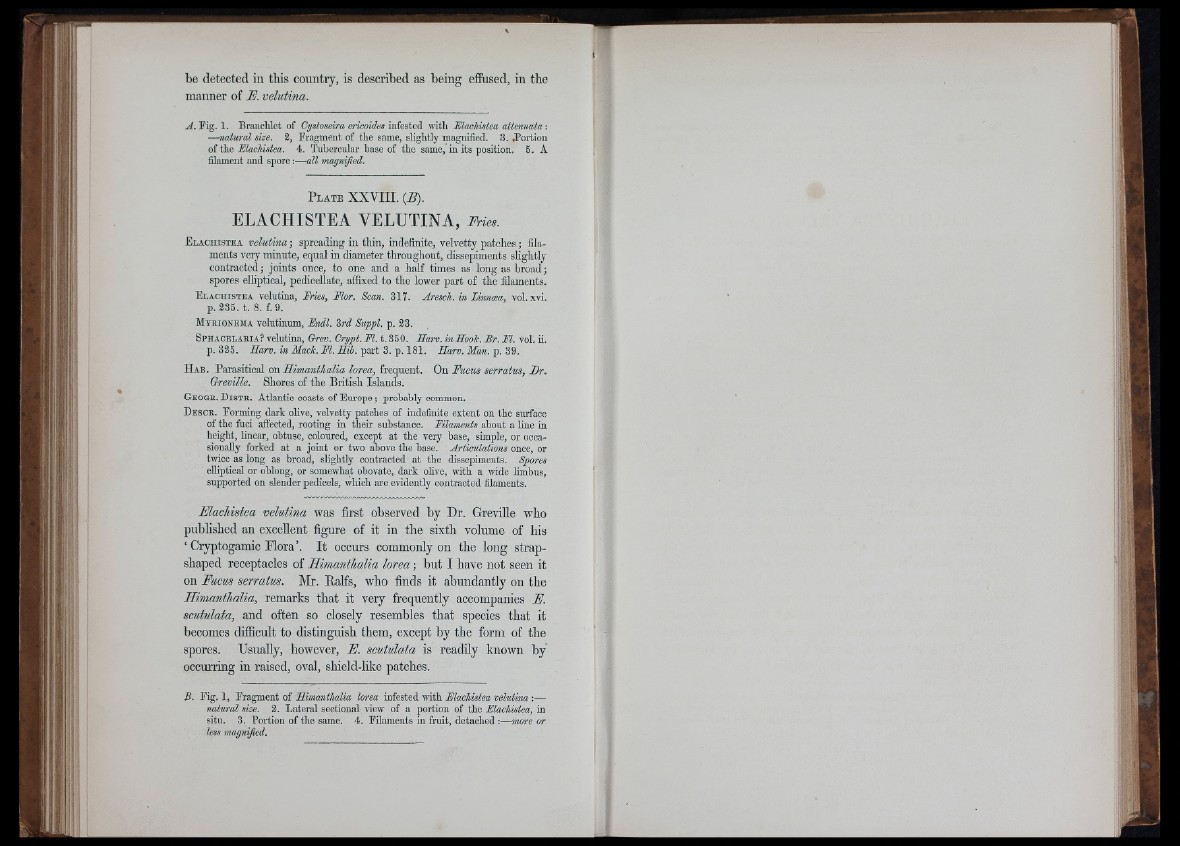
fe
bo detected in this country, is described as being effused, in the
manner of F. velutina.
A. Fig. 1. Branchlet of Cystoseira ericoides with Elaohistea attenuata ■.
— natural size. 3, Fragment of the same, slightly magnified. 3. .Portion
of the Elaohistea. 4. Tubercular base of the same, in its position. B. A
filament and spore -.— all i
P l a t e XXVIII. {B).
ELACHISTEA VELUTINA, Fries.
E l a o h is t e a velutina; spreading in thin, indefmite, velvetty patches; filaments
very minute, equal in diameter tliroughout, dissepiments slightly
contracted; joints once, to one and a half times as long as broad;
spores elliptical, pedicellate, affixed to the lower part of the filaments.
B l a c i i is t e a v e lu tin a , Fries, Elor. Scan. 317. Aresch. in Limuea, v o l. xvi.
p . 235. t. 8. f. 9.
M y r io n em a v e lu tin um , Endl. 3rd Suppl. p . 2 3 .
SpnACELARiA?velutina, Orev. Crypt.El. t.3hH. H a r v .in 3 o o h .E r .El. v o l.i i.
p. 325. Harv. in Mack.El.Hib .-p o .x \,3 .'p .\3 \. XTare. ifo». p. 39.
H a b . Parasitical on Himanthalia lorea, frequent. On Fucus serratus, F r.
Greville. Shores of the British Islands.
G e o g r . D i s t r . Atlantic coasts of Europe; probably common.
D e s c r . Forming d a rt olive, velvetty patches of indefinite extent on the surface
of the fuci aflected, rooting in their substance. Eilaments about a hue in
height, linear, obtuse, coloured, except at the very base, simple, or occasionally
forked at a Joint or two above the base. Articulations once, or
hvice as long as broad, slightly contracted at the dissepiments. Spores
elliptical or oblong, or somewhat obovate, dark olive, with a wide limbus,
supported on slender pedicels, which are evidently contracted filaments.
FlacMstea velutina was first observed by Dr. Greville who
published an excellent figure of it in the sixth volume of his
‘ Cryptogamic Flora’. It occurs commonly on the long strapshaped
receptacles of Himanthalia lorea; but I have not seen it
on Fucus serratus. Mr. Ralfs, who finds it abundantly on the
Himanthalia, remarks that it very frequently accompanies F.
scutulata, and often so closely resembles that species that it
becomes difficult to distinguish them, except by the form of the
spores. Usually, however, F. scutulata is readily known by
occurring in raised, oval, shield-like patches.
S. Fig. 1, Fragment of Himanthalia lorea infested with Elaohistea \
natural size. 2. Lateral sectional view of a portion of the Elaohistea, in
situ. 3. Portion of the same. 4, Filaments in fruit, detached :—more or
less magnijied.